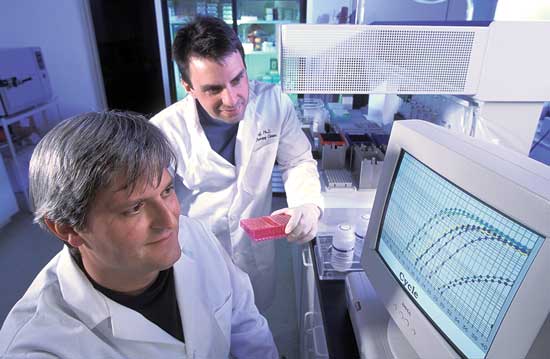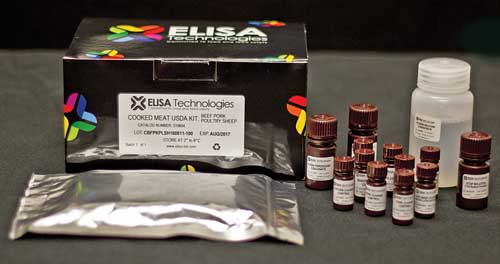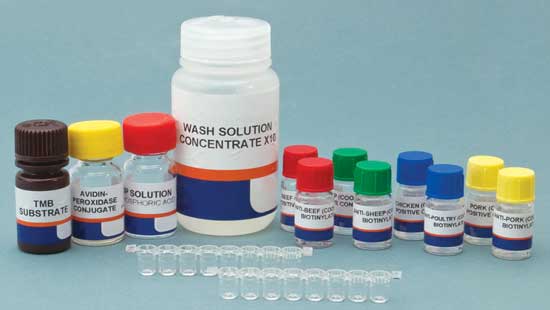Product Authenticity: Identifying Species
FOOD SAFETY & QUALITY
Adulteration of food products with anything that is not supposed to be in them is undesirable for safety, health, religious, cultural, and economic reasons. Methods for detecting adulteration of meat, poultry, and seafood with other species have been developed over the years, arising with increased impetus from the 2013 incident in Europe in which products labeled as ground beef were found to contain undeclared horse meat. Other incidences of meat species adulteration have occurred around the world, dating back to ancient times.
 Detection & Identification Methods
Detection & Identification Methods
A variety of methods have been used for detecting and identifying meat species in raw and processed products, including physical, anatomical, histological, chemical, serological, immunological, and molecular techniques. The two most widely used techniques for meat speciation are enzyme-linked immunosorbent assay (ELISA) and polymerase chain reaction (PCR).
In the ELISA technique, antibodies that bind to specific animal proteins are added to the sample to be analyzed. If an undesired protein is present, it can be detected and quantified based on the amount bound to the antibody. The antibody is linked to an enzyme, and in the final step, a substance containing the enzyme’s substrate is added. The subsequent reaction produces a detectable signal, most commonly a color change in the substrate. The assay is available in microwell and dipstick versions—using indirect, competitive, and sandwich techniques—and produces quantitative results.
In indirect ELISA, a microwell or other surface, such as a dipstick, is coated with an antigen, a specific antibody is added and binds to the antigen and then an enzyme-linked antibody is added and binds to the specific antibody. A substrate is added and converted by the enzyme into a colored or fluorescing product; the rate of color formation is proportional to the amount of specific antibody. In sandwich ELISA, a microwell is coated with an antibody, the antibody binds to an antigen, a second antibody linked to an enzyme binds to the immobilized antigen, and then a substrate is added and converted by the enzyme into a colored or fluorescing product. For sandwich ELISA, the rate of color formation is proportional to the amount of antigen. In competitive ELISA, a bound antibody/antigen complex is added to an antigen-coated well, a secondary antibody coupled to an enzyme is added, and then a substrate is added and converted by the enzyme to produce a color or fluorescence signal.
PCR makes multiple copies of a specific sequence of species-specific DNA. First, the double-stranded target sequence to be copied is separated into two single DNA strands; this is amplification. A pair of primers, short single-stranded sections of DNA that are complementary to the target sequence, bind to either side of the target, and a polymerase builds two new strands of DNA that are duplicates of the original DNA. The process is repeated many times. When the reactions have reached an endpoint, the reaction products are typically detected by gel electrophoresis or fluorescence. PCR can be time-consuming and only provides qualitative results. An improved version called real-time PCR combines the amplification and detection stages to continuously monitor the process via changes in fluorescence over time. It can reach detectable levels of PCR products sooner and is more accurate than endpoint PCR. It can also be designed to give quantitative results (qPCR).
Aside from ELISA and PCR, recent research has also been conducted on various other methods, such as multiple reaction monitoring (MRM) mass spectrometry, MRM cubed, ultraperformance liquid chromatography, Raman spectroscopy and low-field nuclear magnetic resonance, electrospray ionization mass spectrometry, rapid evaporative ionization mass spectrometry, gel electrophoresis and mass spectrometry, liquid chromatography and Fourier transform mass spectrometry, high-performance liquid chromatography and mass spectrometry with MRM and MRM cubed, hyperspectral imaging combining spectroscopy and imaging, and pyro-sequencing. New sequencing methods known as next-generation sequencing (NGS) have also been developed, providing accelerated determination of DNA sequences. NGS has a significant advantage over ELISA and PCR methods as it is nontargeted, allowing identification of any species that might be present, not just those that are targeted.
Testing Kits & Services
BIORON Diagnostics GmbH, Ludwigshafen, Germany (bioron.de), offers RealLine Species Detect food kits to detect pork, camel, horse, beef, chicken, turkey, and lamb, in raw and heated meat, processed food, and feed. The kits are based on real-time PCR detection of species-specific mitochondrial DNA. The company also offers RealLine Food DNA-Extraction kits for isolation of the DNA.
BIOTECON Diagnostics GmbH, Potsdam, Germany (bc-diagnostics.com), offers the foodproof Porcine Detection LyoKit for qualitative detection of contamination with pork and wild boar in processed food by real-time PCR and foodproof animal identification kits for detection of cow, sheep, horse, donkey, chicken, goat, duck, shrimp, and crab in raw and heated meat, feed, and animal products by real-time PCR.
 ELISA Technologies, Inc., Gainesville, Fla. (elisa-tek.com), provides speciation testing services and ELISA kits. ELISA-TEK Raw Meat Species kits are based on species-specific antibodies and qualitatively detect raw mixed meat, cow/pig/poultry, cow/pig/poultry/sheep, cow, pig, poultry, sheep, and horse in uncooked meat, poultry, meat products, eggs, and milk. ELISA-TEK Cooked Meat Species kits are based on antibodies to heat-resistant, species-specific, muscle-related glycoproteins and qualitatively determine animal species content in cooked and canned meat, meat products, processed foods, and meat and bone meals. The MELISA-TEK (Pork or Ruminant) kits are based on monoclonal antibodies to troponin I, a thermostable, skeletal muscle–specific antigen to detect porcine or ruminant muscle protein in meat and bone meals, feed, and raw and cooked foods. The company also offers the EZ Pangasius seafood kit, a field test based on lateral-flow technology and a monoclonal antibody for rapid and sensitive detection of Pangasius fish, which might be sold as a less-expensive substitute for other fish species.
ELISA Technologies, Inc., Gainesville, Fla. (elisa-tek.com), provides speciation testing services and ELISA kits. ELISA-TEK Raw Meat Species kits are based on species-specific antibodies and qualitatively detect raw mixed meat, cow/pig/poultry, cow/pig/poultry/sheep, cow, pig, poultry, sheep, and horse in uncooked meat, poultry, meat products, eggs, and milk. ELISA-TEK Cooked Meat Species kits are based on antibodies to heat-resistant, species-specific, muscle-related glycoproteins and qualitatively determine animal species content in cooked and canned meat, meat products, processed foods, and meat and bone meals. The MELISA-TEK (Pork or Ruminant) kits are based on monoclonal antibodies to troponin I, a thermostable, skeletal muscle–specific antigen to detect porcine or ruminant muscle protein in meat and bone meals, feed, and raw and cooked foods. The company also offers the EZ Pangasius seafood kit, a field test based on lateral-flow technology and a monoclonal antibody for rapid and sensitive detection of Pangasius fish, which might be sold as a less-expensive substitute for other fish species.
Eurofins GeneScan, New Orleans, La. (eurofinsus.com/food-testing/laboratories/eurofins-genescan), offers PCR testing services for detection of DNA from cattle, pig, horse, and other animals, and ELISA tests for animal proteins such as ruminant protein. The company also offers fish authenticity testing, using DNA barcoding as a replacement for traditional morphological and histological approaches. Eurofins GeneScan, Freiburg, Germany (eurofins.de/genescan), offers qualitative real-time PCR screening and identification kits: DNAnimal screen kits for the simultaneous detection of pork and horse/donkey, mammals and birds, ruminants, fish, and birds. DNAnimal Ident kits identify beef and bison, pork (including wild boar), beef and pork, chicken, duck, goose, turkey, goat, sheep, horse, water buffalo, and donkey. Specific extraction methods for highly processed products, such as for gelatin, are also available.
Food and Allergy Consulting and Testing Services, Cape Town, South Africa (factssa.com), offers testing services for identification of meat species in single-ingredient commodities using DNA sequencing and in complex food matrices using species-specific DNA probes to detect 14 different animal species in a single test.
--- PAGE BREAK ---
Genetic ID, Fairfield, Iowa (genetic-id.com), offers PCR testing services for identification of animal species in food and animal feed by real-time PCR. Testing is available for detection of ruminant (cows, sheep, goats, deer, and elk), bovine, ovine, porcine, equine, rabbit, goat, duck and goose, chicken, and turkey. The company also offers fish species verification by both real-time PCR (at its U.S. headquarters) and DNA barcoding methods (at its location in Augsburg, Germany).
Leatherhead Food Research, Leatherhead, Surrey, England (leatherheadfood.com), offers testing services using a single-test multi-species analysis technique based on PCR followed by quantitative DNA sequencing to detect the presence of any DNA-detectable adulterant in raw, cooked, or processed foods. The Adulteration and SPECiation Test combines highly efficient DNA extraction with non-targeted pyro-sequencing, a rapid next-generation sequencing technology.
 Neogen Corp., Lansing, Mich. (neogen.com), offers dipstick and microwell ELISAs and PCR methods to identify meat, poultry, and fish species in raw and cooked food and feed. Biokits for Species Identification are qualitative sandwich-based ELISAs for cooked beef, beef/pork/poultry/sheep, pork, poultry, sheep, raw cow/pig/sheep/poultry, and horse. Biokits F.A.S.T. Immunostick Meat Species Screening Kits are qualitative dipstick assays for cow, horse, pig, poultry, and sheep. BioKits PCR Mastermixes contain everything required for DNA-based PCR assays except target DNA and Taq polymerase and are available for detecting beef, chicken, goat, horse, pork, rabbit, sheep, turkey, cod, coley, haddock, hake, pollock, salmon, trout, and whiting. BioKits DNA Extraction Kit (Speciation) uses magnetic beads to optimize the extraction of DNA from raw and cooked food and feed matrices prior to PCR analysis. Reveal for Ruminant in MBM is an immunochromatographic lateral-flow assay for qualitative analysis of ruminant meat and bone meal in non-ruminant animal meal. Reveal for Ruminant in Feed is an immunochromatographic lateral-flow assay used for the qualitative analysis of ruminant skeletal muscle protein in animal feeds and supplements. The company also offers meat speciation testing services called NeoSeek, using real-time PCR.
Neogen Corp., Lansing, Mich. (neogen.com), offers dipstick and microwell ELISAs and PCR methods to identify meat, poultry, and fish species in raw and cooked food and feed. Biokits for Species Identification are qualitative sandwich-based ELISAs for cooked beef, beef/pork/poultry/sheep, pork, poultry, sheep, raw cow/pig/sheep/poultry, and horse. Biokits F.A.S.T. Immunostick Meat Species Screening Kits are qualitative dipstick assays for cow, horse, pig, poultry, and sheep. BioKits PCR Mastermixes contain everything required for DNA-based PCR assays except target DNA and Taq polymerase and are available for detecting beef, chicken, goat, horse, pork, rabbit, sheep, turkey, cod, coley, haddock, hake, pollock, salmon, trout, and whiting. BioKits DNA Extraction Kit (Speciation) uses magnetic beads to optimize the extraction of DNA from raw and cooked food and feed matrices prior to PCR analysis. Reveal for Ruminant in MBM is an immunochromatographic lateral-flow assay for qualitative analysis of ruminant meat and bone meal in non-ruminant animal meal. Reveal for Ruminant in Feed is an immunochromatographic lateral-flow assay used for the qualitative analysis of ruminant skeletal muscle protein in animal feeds and supplements. The company also offers meat speciation testing services called NeoSeek, using real-time PCR.
PCR max, Staffordshire, England (pcrmax.com), offers the Eco 48 and Delta Seek speciation kits for use with the Eco 48 qPCR instrument for detection of relevant species.
Primerdesign Ltd., Chandler’s Ford, England (genesig.com), offers genesig detection kits designed to work with any real-time PCR instrument on the market. Kits are available for horse, sheep, goat, pig, Atlantic cod, buffalo, cat, chicken, coley, beef, deer, dog, donkey, duck, and European eel. The kits are based on PCR amplification of a unique species-specific tag present in the mitochondrial genome, ensuring specific detection of the desired species while excluding other related species. The new EASY and Advanced speciation formats contain additional components to maximize accuracy; they are supplied in a multiplex format enabling both species-specific and universal meat detection in a single well.
Scientific Analysis Laboratories, Manchester, England (salltd.co.uk), offers meat speciation testing services for raw and cooked meat products, using real-time PCR.
Reading Scientific Services Ltd., Uxbridge, England (rssl.com), offers testing services to detect animal species in raw and processed foods. The company offers PCR testing for buffalo, cat, chicken, cow, deer (fallow, red, and roe), dog, duck, goat, goose, hare, horse, human, kangaroo, mouse, ostrich, pig, rabbit, rat, sheep, and tuna (skipjack, yellow fin, blue fin, and big eye), turkey, white fish (haddock, plaice, Atlantic cod, Pacific cod, Alaskan pollock, and pollock), and salmon (chum, pink, and sockeye) and real-time PCR testing for chicken, cow, horse, and pig.
SCIEX, Concord, Ontario (sciex.com), offers meat speciation and authenticity testing services, including testing for horse and pork in beef products by use of the QTRAP 5500 system and the LC-MS/MS method for identification of specific biomarker peptides developed at the Institute of Food Chemistry at University of Muenster, Germany.
Government Agencies
The Food Safety & Inspection Service (FSIS) of the U.S. Dept. of Agriculture (USDA) conducts species verification on both imported and domestic samples and specifies use of meat speciation tests in its Microbiology Laboratory Guidebook. The agency is presently using Neogen’s BioKits F.A.S.T. Immunostick Meat Speciation kits for raw species and Elisa Technologies’ ELISA-TEK Cooked Meat Speciation Kits for cooked samples. The FSIS and the USDA’s Agricultural Research Service are considering real-time and multiplex PCR kits that can be used for quantitation purposes.
The U.S. Food and Drug Administration (FDA), in collaboration with the University of Guelph and the Smithsonian National Museum of Natural History, has developed and validated the method known as DNA barcoding, similar to the universal product code, for identification of fish species. This technique compares a specific gene sequence of an unknown specimen to a database of known species. The Barcode of Life database, hosted by the University of Guelph, includes DNA sequences for the mitochondrial gene cytochrome oxidase 1 (CO1) and has been successfully used to detect mislabeled fish. Designed to help federal, state, and local officials and purchasers of seafood identify species substitution and economic deception in the marketplace, the FDA’s Regulatory Fish Encyclopedia includes tissue protein patterns determined by isoelectric focusing electrophoresis and CO1 mitochondrial DNA sequence patterns determined by DNA barcoding.
The Bureau of Food Laboratories of the Florida Dept. of Agriculture and Consumer Services uses its Fish Speciation Program to routinely monitor misbranding activity by sequencing fish DNA and comparing results to a standardized library to identify the fish being sold.
 Neil H. Mermelstein, IFT Fellow,
Neil H. Mermelstein, IFT Fellow,
Editor Emeritus of Food Technology
[email protected]


